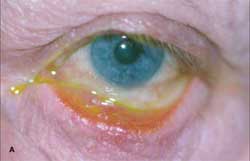Ectropion
A 73-year-old man presented with constant watering, irritation, and redness of the left eye. An outward turning of the left lower eyelid was noted. The palpebral conjunctiva exhibited hyperemia and thickening. Keratinization of the exposed conjunctiva indicated that this was a long-standing lower lid ectropion. Slit-lamp examination revealed superficial punctate keratopathy in the inferior one third of the cornea.
A 73-year-old man presented with constant watering, irritation, and redness of the left eye. An outward turning of the left lower eyelid was noted (A). The palpebral conjunctiva exhibited hyperemia and thickening. Keratinization of the exposed conjunctiva indicated that this was a long-standing lower lid ectropion. Slit-lamp examination revealed superficial punctate keratopathy in the inferior one third of the cornea.

Laxity of both the medial and lateral canthal tendons was present. Based on this finding,an involutional ectropion was diagnosed.
Progressive weakening of the canthal tendons from aging and gravitational forces causes the lid to fall away from the eyeball. This leads to tearing and more frequent eyelid rubbing, which further weakens the tendons.

Surgical repair is the most effective treatment for an ectropion. This patient underwent a combination medial spindle procedure (to tighten the medial canthal tendon) and a lateral canthal strengthening procedure.
The left lower eyelid continues to function well 3 years after surgery (B). The eyelid is apposed to the globe with no laxity or conjunctival exposure (the pupil was pharmacologically dilated for a routine eye examination).